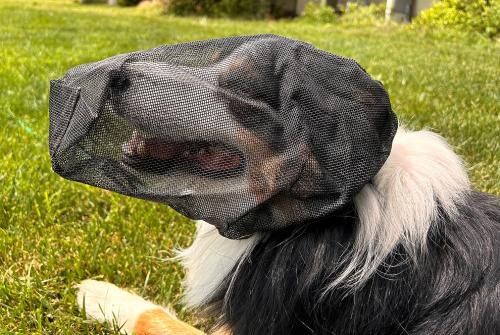
Foxtails and Dogs
What are foxtail foreign bodies?
Takeaways
- Foxtails are spiked seed heads found on some plants and grasses.
- Foxtails can enter the body and migrate into tissues, causing abscesses and infections.
- Foxtails are especially dangerous to pets in the summer months when they have dried out and hardened.
- The only treatment for foxtail foreign bodies is removal of the foxtail(s).
- The best way to prevent foxtail foreign bodies is to keep pets out of areas where foxtails may be encountered.
Foxtails are spiked seed clusters found on some weed plants and wild grasses. In Northern California, these can include foxtail grasses, barley and millets, plants often encountered on hiking trails, roadsides, and in backyards and open fields. Foxtails get their name because the shape of the seed head resembles the bushy tails of foxes. These spiked seed heads can pose severe health risks by migrating into tissues where they can cause abscesses and widespread infections.
Foxtails are especially dangerous when they have dried out and hardened, typically during the summer months. However, cases are seen throughout the year in warm climates. Foxtail-associated conditions are more commonly observed in dogs than cats, but can potentially adversely affect domestic, feral, and wild animals.
Foxtails most commonly enter the body through the nose, mouth, ears, and eyes. However, they can also penetrate the skin, causing wounds and abscesses. Thanks to its shape, which is intended to burrow seeds into the soil, once the foxtail is in the body it cannot reverse direction and come out on its own. Over time, embedded foxtails can work their way through tissues, sometimes even migrating into the brain, lungs, and other vital organs.
What are the clinical signs of foxtail foreign bodies?
The clinical signs of foxtail foreign bodies are frequently associated with the affected area of the body. If a foxtail has entered through the nose and/or throat, the animal may exhibit persistent sneezing, snorting, nasal discharge, shaking of the head, pawing at the head, head tilting, or gagging. If it has entered through the paw, the animal may limp on the affected limb. Excessive licking of a specific area may also indicate the presence of a foxtail. If a foxtail has entered the eye area, uncontrolled blinking and swelling may be observed. Unfortunately, these signs are also found with a variety of other ailments. Unless you are aware that your pet has been exposed to foxtails, it can be difficult to determine the source of the animal’s discomfort.
If the site becomes infected, clinical signs may include lethargy, fever, swelling, and not wanting to eat. Infection can also lead to abscesses and open sores.
How are foxtail foreign bodies diagnosed?
Diagnosis of a foxtail foreign body is determined through combinations of patient history (i.e. known exposure to foxtails), physical examination, diagnostic testing (blood and serum testing), biopsies, and diagnostic imaging (ultrasound, X-rays, computed tomography (CT), MRI, endoscopy, bronchoscopy, etc.). In some cases, surgical exploration is required to find the foxtail.
How are foxtail foreign bodies treated?
The only treatment for foxtails is removal. If you find a foxtail on your pet that is easily accessible, you can remove it with tweezers. In these cases, it is important to make sure that you have removed the whole seed head. Remnants can still migrate through the pet’s body. If you think that any seed parts remain, call your veterinarian. If the foxtail is embedded in the skin, causing redness or swelling, take your pet to a veterinarian. Early diagnosis and removal is ideal. The deeper a foxtail migrates into the body, the more likely surgery will be required to find and remove it.
What is the prognosis for foxtail foreign bodies?
The short-term outcome for foxtail-associated lesions is good, and most cases can be managed on an outpatient basis. Some cases require short hospital stays. A minority of cases develop life-threatening disease and may require a combination of imaging, endoscopy, and surgery to resolve the condition.
How can foxtail foreign bodies be prevented?
The best ways to prevent foxtail-associated conditions include:

- Being observant of where your dog walks and plays.
- Avoiding areas where foxtails grow in the summer months. Stick to paved paths as much as possible. If you must walk through areas with foxtails, keep your dog on a leash.
- Keeping the hair between the toes, ears, and belly trimmed, especially for longhaired dogs. Foxtails can easily attach to long hair.
- Taking your dog to the veterinarian as soon as possible if you notice head shaking or persistent sneezing after being in an area with foxtails. These are common signs of foxtails in the nose and ears. In general, foxtail retrieval is easier the sooner it is identified.
- Grooming your pets carefully, especially after they have been around areas that may have foxtails. Check between their toes, as well as in their ears, armpits, and groin areas.
- Using a safety net that can be attached to a dog’s collar. However, remember that this won’t protect other parts of the body, so proper grooming is still important.
- Removing foxtails from your yard at home. Individual plants can be pulled out. Removal on a larger scale usually requires herbicides.
For more information
UC IPM - Foxtails: https://ipm.ucanr.edu/PMG/WEEDS/foxtails.html
Philp, HS, Epstein, SE, Hopper, K. Clinical and clinicopathological characteristics, treatment, and outcome for dogs and cats with confirmed foxtail foreign body lesions: 791 cases (2009–2018). J Vet Emerg Crit Care. 2022; 32: 653– 662.
Olstad, Erik. Pet Owners: Watch Out for Foxtail Seed Pods That Can Harm Your Dog or Cat This Summer. The Conversation May 9, 2024
*This article may not be reproduced without the written consent of the UC Davis School of Veterinary Medicine.
